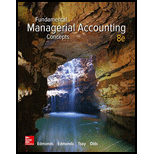
a.
Ascertain the
a.
Explanation of Solution
Net present value method:
Net present value method is the method which is used to compare the initial
Ascertain the net present value of each opportunity, and state whether person K should approve the given project or not as follows:
Opportunity 1:
| Net present value of opportunity 1 | |||
| Year | Net cash flow (A) | Present value of $1 at 8% [from table 1 in appendix ](B) | Present value of net cash flow |
| 1 | $44,000 | 0.925926 | $40,740.74 |
| 2 | $47,200 | 0.857339 | $40,466.40 |
| 3 | $63,200 | 0.793832 | $50,170.18 |
| 4 | $80,000 | 0.735030 | $58,802.40 |
| Total present value of | $190,179.73 | ||
| Less: Cost of investment | $160,000.00 | ||
| Net present value of the project | $ 30,179.73 | ||
Table (1)
Opportunity 2:
| Net present value of opportunity 2 | |||
| Year | Net cash flow (A) | Present value of $1 at 8% [from table 1 in appendix ](B) | Present value of net cash flow |
| 1 | $81,600 | 0.925926 | $75,555.56 |
| 2 | $86,400 | 0.857339 | $74,074.09 |
| 3 | $16,000 | 0.793832 | $12,701.31 |
| 4 | $16,000 | 0.735030 | $11,760.48 |
| Total present value of cash flows | $174,091.44 | ||
| Less: Cost of investment | $160,000.00 | ||
| Net present value of the project | $14,091.44 | ||
Table (2)
In this case, opportunity 1is better for the investment, because opportunity 1 ($30,179.73) has higher net present value than opportunity 2 ($14,091.44).
b.
Compute the payback period for each project, and state whether person K should approve the given project or not.
b.
Explanation of Solution
Payback period: Payback period is the expected time period which is required to recover the cost of investment. It is one of the capital investment method used by the management to evaluate the proposal of long-term investment (fixed assets) of the business.
Compute the payback period for each project, and state whether person K should approve the given project or not as follows:
Opportunity 1:
| Cash payback period of opportunity 1 | ||
| Years and months | Net cash flows ($) | Cumulative net cash flows ($) |
| 1 | 44,000 | 44,000 |
| 2 | 47,200 | 91,200 |
| 3 | 63,200 | 154,400 |
| 1 month (1) | 5,600 | 160,000 |
Hence, the cash payback period of opportunity 1 is 3 years and 1 month.
Opportunity 2:
| Cash payback period of opportunity 2 | ||
| Year and months | Net cash flows | Cumulative net cash flows |
| 1 | 81,600 | 81,600 |
| 11 months (2) | 78,400 | 160,000 |
Hence, the cash payback period of opportunity 2 is 1 year and 11 months.
In this case, opportunity 2 is better for the investment, because opportunity 2 has shorter payback period than opportunity 1.
Working note:
Calculate the number of months in the cash payback period of opportunity 1:
Calculate the number of months in the cash payback period of opportunity 2:
c.
Compare the net present value approach will the payback approach, and state the method which is better for the given circumstance.
c.
Explanation of Solution
Compare the net present value approach will the payback approach, and state the method which is better for the given circumstance as follows:
The net present value approach represents the net cash flow with consideration of the time value of money, whereas cash payback technique neglects cash flows occurring after the payback period, and it does not use the present value concept (time value of money) in valuing cash flows that are occurring in the different time period. In other word, payback period approach measures the risk of the investment rather than the profitability.
If an investor is very concerned about the risk of an investment, the payback period approach is best for the decision making. Under this circumstance, opportunity 2 is better for the investment.
If an investor is very concerned about the profitability of an investment, the net present value approach is best for the decision making. Under this circumstance, opportunity 1 is better for the investment.
Want to see more full solutions like this?
Chapter 10 Solutions
Fundamental Managerial Accounting Concepts
- Calculate the profit margin accountingarrow_forwardQuestion: 26.3 - At the beginning of the year, Downtown Athletic had an inventory of $200,000. During the year, the company purchased goods costing $800,000. If Downtown Athletic reported ending inventory of $300,000 and sales of $1,050,000, their cost of goods sold and gross profit rate must be ..........................................arrow_forwardExpert of Account Solve this asaparrow_forward

 AccountingAccountingISBN:9781337272094Author:WARREN, Carl S., Reeve, James M., Duchac, Jonathan E.Publisher:Cengage Learning,
AccountingAccountingISBN:9781337272094Author:WARREN, Carl S., Reeve, James M., Duchac, Jonathan E.Publisher:Cengage Learning, Accounting Information SystemsAccountingISBN:9781337619202Author:Hall, James A.Publisher:Cengage Learning,
Accounting Information SystemsAccountingISBN:9781337619202Author:Hall, James A.Publisher:Cengage Learning, Horngren's Cost Accounting: A Managerial Emphasis...AccountingISBN:9780134475585Author:Srikant M. Datar, Madhav V. RajanPublisher:PEARSON
Horngren's Cost Accounting: A Managerial Emphasis...AccountingISBN:9780134475585Author:Srikant M. Datar, Madhav V. RajanPublisher:PEARSON Intermediate AccountingAccountingISBN:9781259722660Author:J. David Spiceland, Mark W. Nelson, Wayne M ThomasPublisher:McGraw-Hill Education
Intermediate AccountingAccountingISBN:9781259722660Author:J. David Spiceland, Mark W. Nelson, Wayne M ThomasPublisher:McGraw-Hill Education Financial and Managerial AccountingAccountingISBN:9781259726705Author:John J Wild, Ken W. Shaw, Barbara Chiappetta Fundamental Accounting PrinciplesPublisher:McGraw-Hill Education
Financial and Managerial AccountingAccountingISBN:9781259726705Author:John J Wild, Ken W. Shaw, Barbara Chiappetta Fundamental Accounting PrinciplesPublisher:McGraw-Hill Education





